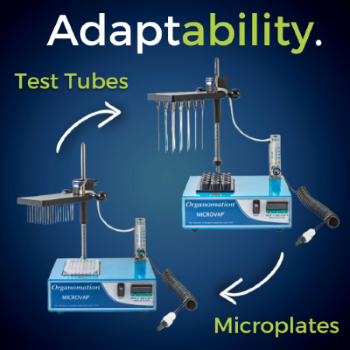Product Information, Microplate Evaporators, Sample Concentration Options
/ Sarah Johnson
Many analytical and research laboratories work on a variety of projects, each one requiring their own procedures, supplies, and instrumentation. Having to purchase unique equipment for each procedure is not only quite costly, but inefficient and a waste of valuable space. Having a slew of different analytical instruments will quickly fill limited benchtop and fume hood space, which is a common concern among laboratories, particularly small or private labs.
Organomation's MICROVAP evaporator is the perfect all-in-one solution. This versatile nitrogen concentrator is designed to accommodate multiple projects with its optional conversion kit. The standard MICROVAP models are able to hold either test tubes or a 96 well microplate. But what if your applications require you to concentrate both? Instead of purchasing a second MICROVAP unit, you can simply purchase a conversion kit, which is sold at a fraction of the price of a new unit.
This conversion kit includes a new nitrogen distribution manifold and heat block to accommodate either a 96 well microplate or 15-24 sample tubes. The parts are easily interchangeable, allowing you to switch back and forth between sample types. The video below demonstrates how easy it is to install this conversion kit.
The conversion kit allows you to essentially purchase two units in one, making it perfect for labs with multiple procedures who have a tight budget or limited benchtop space. The MICROVAP remains as one of Organomation's most compact and affordable evaporators. Paired with its unique design and adaptability, it continues to be a staple in many laboratories around the world.
How Vials and Microplates Can Complement Each Other
In toxicology laboratories for instance, both test tubes and 96-well plates play crucial roles, each suited to different stages of sample preparation and analysis. Test tubes are typically used for initial sample collection and primary processing due to their ability to handle larger volumes and robust physical processes such as centrifugation, mixing, and storage. They allow for flexible and manual sample manipulation, including dilution, enzymatic hydrolysis, and protein precipitation, which are essential for preparing urine samples for further testing. Test tubes also facilitate the secure handling and aliquoting of samples, ensuring quality control and preserving sample integrity before they are processed further.
Once the initial preparation is complete, samples are often transferred to 96-well plates, which are designed for high-throughput and automated analyses. These plates are ideal for small-volume assays where multiple samples need to be processed in parallel with precision and consistency. They are particularly useful for various analytical tests in toxicology, such as drug screening, biomarker analysis, hormone and steroid testing, and the detection of toxic substances. The 96-well format reduces reagent use and is compatible with automated liquid handling systems, enhancing efficiency and minimizing manual errors.
Moreover, 96-well plates integrate seamlessly with automated instruments like plate readers, enabling rapid and sensitive detection through colorimetric, fluorometric, or luminescent assays. This high-throughput capability is essential for laboratories handling large volumes of samples, providing uniform assay conditions and improving data reliability and reproducibility. Additionally, the design of these plates helps minimize cross-contamination and supports the safe, disposable usage critical for avoiding contamination in sensitive assays.
By utilizing test tubes for initial sample handling and 96-well plates for detailed, high-throughput analysis, laboratories can maintain workflow efficiency, ensure high-quality results, and meet the specific needs of different analytical tests. This combined approach leverages the strengths of both formats to maximize productivity and accuracy in toxicology testing.
Affordable Microplate Sample Preparation
While heavily automating the entire process, from liquid dispensing through sample preparation and analysis can be done, most laboratories cannot currently afford or justify this approach. In many cases, transitioning to micro-well plates, or utilizing them when they are more efficient that sample vials, is enough of a boost to throughput by analyzing more samples at once. The most popular automated microplate evaporators on the market can costs over $12,000 dollars which is only a good investment for the laboratory processing 100+ plates each week. For the majority of laboratories, investing in an option capable of processing one or three microplates at a time, at under half that price, is a much more sensible approach.
Organomation’s MICROVAP evaporator, capable of concentrating both samples held in sample vials and microplates, provides the best value on the market for laboratories taking advantage of the complimentary relationship between these two approaches as discussed above.
If you have any questions on the MICROVAP nitrogen evaporator and its conversion kit, or if you would like a formal quote, please email us at sales@organomation.com or call us at (978) 838-7300.
Last updated: June 26, 2024
